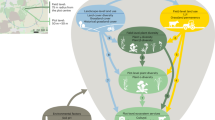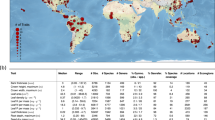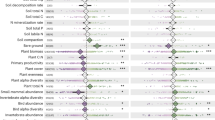Abstract
Giant trees that have acquired their own unique identities are often named by local people and can inspire a sense of awe and become objects of faith. Although these giant trees provide various kinds of spiritual ecosystem services that benefit the spiritual well-being of human society, the drivers of these services remain unclear. Using structural equation modelling with 38,994 records of giant trees of 237 species across Japan, this study shows that macroecological processes such as annual precipitation and temperature may drive spiritual ecosystem services obtained from giant trees directly and indirectly via tree properties such as size and age.
This is a preview of subscription content, access via your institution
Access options
Access Nature and 54 other Nature Portfolio journals
Get Nature+, our best-value online-access subscription
$29.99 / 30 days
cancel any time
Subscribe to this journal
Receive 12 digital issues and online access to articles
$119.00 per year
only $9.92 per issue
Buy this article
- Purchase on Springer Link
- Instant access to full article PDF
Prices may be subject to local taxes which are calculated during checkout

Similar content being viewed by others
Data availability
The giant tree data were downloaded from the giant trees database in Japanese (https://kyoju.biodic.go.jp/) on 19 November 2022. The climate data were downloaded from Mesh Climate Data 2010 (Japan Meteorological Agency, http://nlftp.mlit.go.jp/ksj/gml/datalist/KsjTmplt-G02.html). The compiled dataset is available on figshare (https://doi.org/10.6084/m9.figshare.21200563).
Code availability
The code for the piecewise SEM statistical analysis is available on figshare (https://doi.org/10.6084/m9.figshare.21200563).
References
Lindenmayer, D. B. & Laurance, W. F. The ecology, distribution, conservation and management of large old trees. Biol. Rev. Camb. Phil. Soc. 92, 1434–1458 (2017).
Voigt, C. C., Borissov, I. & Kelm, D. H. Bats fertilize roost trees. Biotropica 47, 403–406 (2015).
Blicharska, M. & Mikusiński, G. Incorporating social and cultural significance of large old trees in conservation policy. Conserv. Biol. 28, 1558–1567 (2014).
Sponsel, L. E. Spiritual Ecology: A Quiet Revolution (ABC-CLIO, 2012).
Omura, H. Trees, forests and religion in Japan. Mt. Res. Dev. 24, 179–182 (2004).
Heintzman, P. Nature-based recreation and spirituality: a complex relationship. Leis. Sci. 32, 72–89 (2009).
Irvine, K. N., Hoesly, D., Bell-Williams, R. & Warber, S. L. in Biodiversity and Health in the Face of Climate Change (eds Marselle, M. R. et al.) 213–247 (Springer, 2019).
Millennium Ecosystem Assessment Ecosystems and Human Well-Being: Synthesis (Island Press, 2005).
Vihervaara, P., Rönkä, M. & Walls, M. Trends in ecosystem service research: early steps and current drivers. Ambio 39, 314–324 (2010).
Brown, J. H. Macroecology (Univ. Chicago Press, 1995).
Piovesan, G. & Biondi, F. On tree longevity. New Phytol. 231, 1318–1337 (2021).
Matsui, K. Geography of Religion in Japan: Religious Space, Landscape, and Behavior (Springer, 2013).
Lefcheck, J. S. piecewiseSEM: piecewise structural equation modelling in R for ecology, evolution, and systematics. Methods Ecol. Evol. 7, 573–579 (2016).
Giant Trees Follow-Up Survey Report, the Sixth Census of the National Survey of the Natural Environment (in Japanese) (Biodiversity Center of Japan & Ministry of the Environment, 2001); https://www.biodic.go.jp/reports2/6th/kyojuflup/6_kyojuflup.pdf
Makino, K. Folkloristics of Giant Trees (in Japanese) (Kobunsha, 1986).
Daniel, T. C. et al. Contributions of cultural services to the ecosystem services agenda. Proc. Natl Acad. Sci. USA 109, 8812–8819 (2012).
Muthukrishna, M. et al. Beyond Western, Educated, Industrial, Rich, and Democratic (WEIRD) psychology: measuring and mapping scales of cultural and psychological distance. Psychol. Sci. 31, 678–701 (2020).
Twigger-Ross, C. L. & Uzzell, D. L. Place and identity processes. J. Environ. Psychol. 16, 205–220 (1996).
Mittermeier, R. A., Turner, W. R., Larsen, F. W., Brooks, T. M. & Gascon, C. in Biodiversity Hotspots (eds Zachos, F. E. & Habel, J. C.) 3–22 (Springer, 2011).
Watanabe, T., Matsunaga, K., Kanazawa, Y., Suzuki, K. & Rotherham, I. D. Landforms and distribution patterns of giant Castanopsis sieboldii trees in urban areas and western suburbs of Tokyo, Japan. Urban For. Urban Green. 60, 126997 (2021).
Uryu, S. jpmesh: Utilities for Japanese Mesh Code. R package version 2.1.0 https://CRAN.R-project.org/package=jpmesh (2022).
R Core Team R: A Language and Environment for Statistical Computing (R Foundation for Statistical Computing, 2022).
Yamanouchi, T. et al. A Checklist of Japanese Plant Names (Japan Node of Global Biodiversity Information Facility, 2019); https://www.gbif.jp/v2/activities/wamei_checklist.html
Acknowledgements
I thank Y. Nakawake for suggestions on literature related to cultural studies. R.N. was supported by the Japan Society for the Promotion of Science (grant no. 22K15188) and the National Institute for Environmental Studies, Japan.
Author information
Authors and Affiliations
Corresponding author
Ethics declarations
Competing interests
The author declares no competing interests.
Peer review
Peer review information
Nature Plants thanks Malgorzata Blicharska for their contribution to the peer review of this work.
Additional information
Publisher’s note Springer Nature remains neutral with regard to jurisdictional claims in published maps and institutional affiliations.
Extended data
Extended Data Fig. 1
Initial model structure for piecewise SEM analysis.
Supplementary information
Rights and permissions
Springer Nature or its licensor (e.g. a society or other partner) holds exclusive rights to this article under a publishing agreement with the author(s) or other rightsholder(s); author self-archiving of the accepted manuscript version of this article is solely governed by the terms of such publishing agreement and applicable law.
About this article
Cite this article
Nakadai, R. Macroecological processes drive spiritual ecosystem services obtained from giant trees. Nat. Plants 9, 209–213 (2023). https://doi.org/10.1038/s41477-022-01337-1
Received:
Accepted:
Published:
Issue Date:
DOI: https://doi.org/10.1038/s41477-022-01337-1



